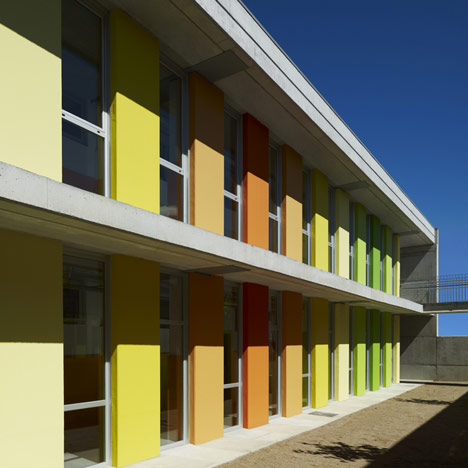
Les Cabanyes by Arqtel Barcelona
This Barcelona school by architects Arqtel Barcelona has an exposed concrete structure with painted vertical bands of citrus colours.
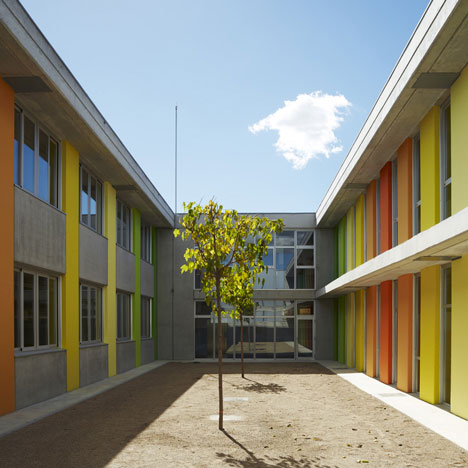
Containing both a preschool and primary school, the Les Cabanyes school is arranged along an axis that extends from north to south.
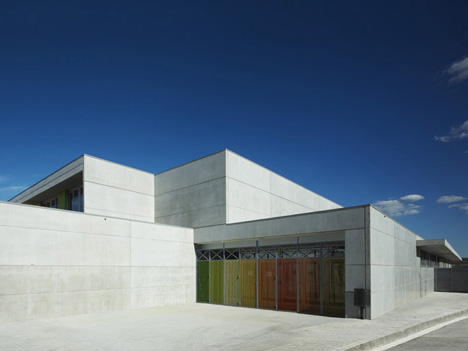
Classrooms face enclosed courtyards, containing playgrounds and outdoor learning areas.
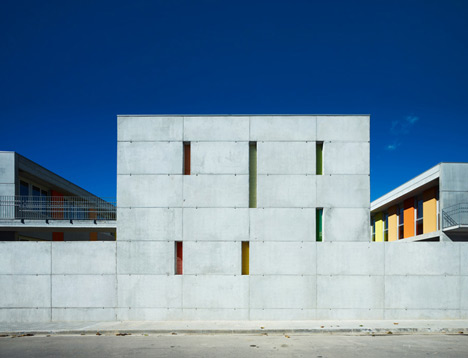
More education buildings on Dezeen »
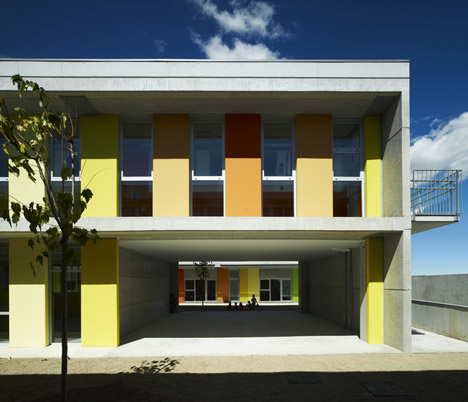
Photography is by Eugeni Pons.
The following information is from Arqtel Barcelona:
Les Cabanyes Preschool and Primary School, Barcelona
A project is defined by the people who will use it and by how it is situated on the site. When it comes to children, it is important to take special care to address all of their needs by providing warm, pleasant and comfortable surroundings. This project prioritizes attention to detail and is designed within a clear and simple functional framework.
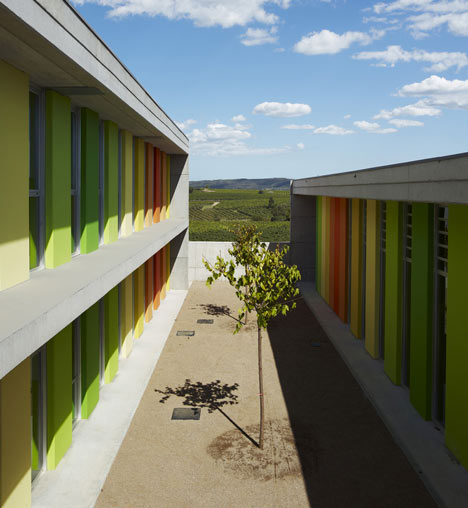
The building’s location reflects a particular understanding of an urban fragment and its unique qualities. The building’s arrangement on the site takes advantage of its specific characteristics. This building generates a dialogue with its surroundings not only through its spatial composition and architectural tectonics but also through its volumetric orientation. As a result, the building optimizes functional program at the same time as it focuses on aspects of light, orientation and the quality of the spaces generated. Retaining a telluric presence, the building brings a sense of order to the site and acts as a landmark among surrounding buildings and fields. Its presence as a building volume makes legible a reading of the building through its organization. Its north-south longitudinal axis opens up in a circulation pattern resembling a comb, alternating playfully between filled and empty spaces that characterize the whole.
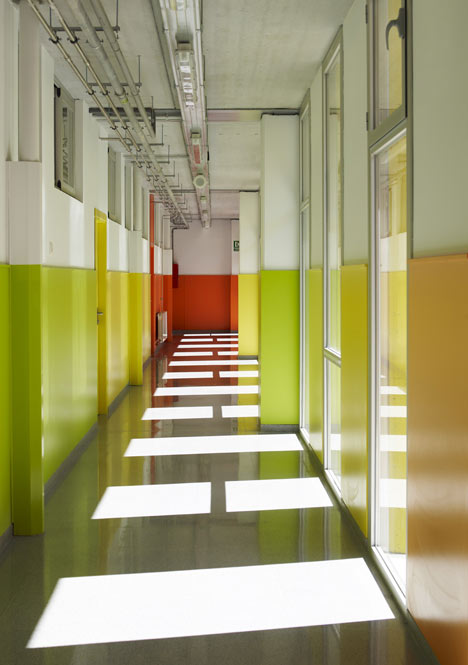
The north-south axis, which connects the entire building, opens up to an outdoor, public sphere of access. From here, circulation flows into the preschool and primary school areas are separated, avoiding undue disruption as the children walk to their classrooms. This linear axis, a two-story high space, is marked as intensely as the secondary interior courtyards that organize and link spaces and their associated cross axes, varying according to different programmatic needs. These secondary courtyards function as a preschool playground, the primary school playground, the sports field, and a garden area or courtyards for basking in natural light and relaxing. To react to these varying functions, the façade reflects stratified layers of the building volume.
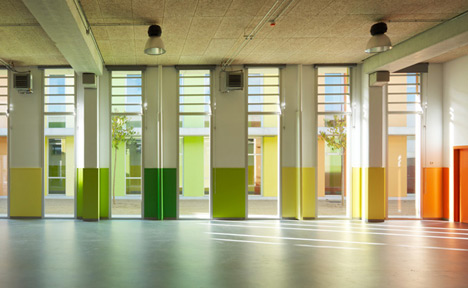
The building’s orthogonality allows for construction elements that are linear and of limited depths. This purposefully minimizes the extension of building elements into the courtyards to maximize exterior space. This also minimizes the area of the site occupied by building. The entire area is meant to be used with equal intensity; this strategy dictates the location of different programmatic pieces within the building. This same linking mechanism sponsors rhythm from the repetition of the pieces; it unifies them by serving as a datum for the interior spaces.
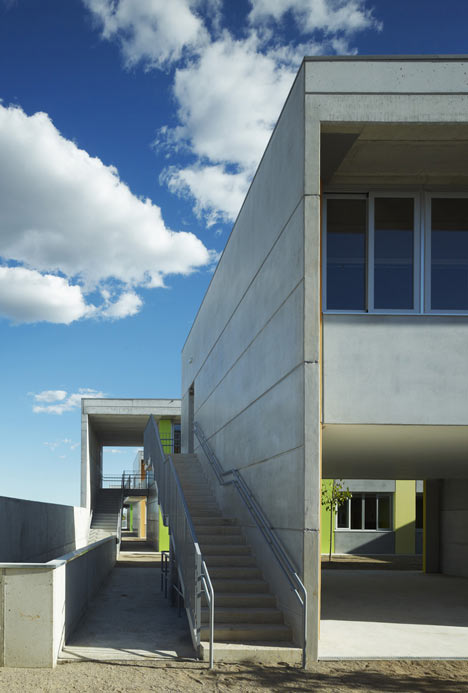
The northernmost linear piece of the school houses the spaces for the youngest children, with classrooms open to the south. These spaces serve as a refuge from which the children can observe the real world and happenings outside through a transparent and ever-changing wall. At the same time, they are warmed by the heat and light of the sun while they play.
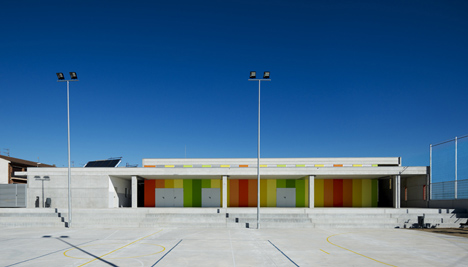
In a similar spatial organization, the central longitudinal volumes are linked by the layout of the classroom spaces that face north to prevent overexposure to the sun. The opening of the corridors to the secondary courtyards allows these circulatory spaces to act as warm and welcoming environments.
The longitudinal piece is designed as an element of closure and transition. In other words, the gymnasium and multipurpose room at the southern-most end serves as a terminus to the north-south grain but also acts as an independent element, accessible with or without engagement from the rest of the building.
The stratification of the facades realizes an intention to create a modern and dynamic presence. The result reflects a kind of animated architectural and material character with exposed concrete walls on the facades of the longitudinal axes. While the facades give shape to the secondary courtyards, they also provide a counterpoint to the materiality of the aforementioned facades. Here, the facades are painted in lively colours, evoking a sense of warmth and joy. They alternate with the transparent sections which are resolved very differently in relation to the interior spaces.
The building section is characterized by its adaptation to the topography and orientation allowing different spaces to receive abundant natural light. When this light is combined with the colours of the corridors and the classrooms, it creates a play of light and shadow within warm and pleasant spaces.
Concerns about the environment and sustainable development have become increasingly important for construction methodologies at large. In accordance with the triple dimension of sustainability - environmental, social and economic – the building is inspired by and adheres to these criteria of environmental excellence. The school is presented as an example of sustainable architecture from its conception and design, ranging from passive climate control systems to the construction. To satisfy the building’s energy demands, it utilizes renewable energy systems such as photovoltaic or solar panels.
With the intention of employing innovative thinking in construction methods, prefabricated systems have been used for the structure, facade and partitions. These systems have enabled the architect to reduce construction time considerably, provide construction elements of outstanding quality, reduce noise and dust emissions and lower the time and waste generated by the construction process itself.
To ensure significant energy savings, both in terms of heating as well as electricity consumption, we have used double walls with thermal inertia complemented by exterior doors and windows with thermal breaks. Other energy-saving tools include the placement of mechanisms to control the interior solar light level, water-saving mechanisms and presence detectors in the rest rooms and changing rooms to control the use of artificial light.
The prefabricated structure is based on the Deltamix system, composed of reinforced concrete pillars sized for one or several floors, pre-stressed hollow-core slabs and DELTABEAM concrete-steel beams. These beams feature a metallic core, which creates a concrete-steel beam when joined to the hollow-core slabs. This beam is highly resistant to flexion, torsion and shear stress and also has excellent fire-resistant properties.
One of the notable advantages of this system is the total absence of suspended beams below the frame of the hollow-core slabs, allowing for thin flat slabs with bases of minimum thickness. Other advantages offered by this system include the reduction in overall construction time and the ability to capture light up to 12 meters with large open spaces. Additionally, the system offers fire resistance up to 180 minutes, elimination of the need for bracing, better acoustic insulation and minimization of the period of environmental impact. It increases the building’s durability with the use of better materials and high-quality products as well as making waterproofing easier. The system also optimizes the building’s life cycle, facilitates the making of spaces of diverse sizes and makes the assembly process safer. Efforts to partition spaces and construct holes for electrical systems as well as other installations are minimized and slabs are reduced to its optimal thickness.
The facades are made of 15 cm or 20 cm-thick prefabricated exposed concrete panels that are painted in one of six different colors or left with an exposed concrete finish. The prefabricated panels are reinforced with an interior double drywall sheet that is 13 mm thick. The 46 mm frame with insulation and the air chamber allows for adequate thermal and acoustic insulation.
The anchoring systems of the upper and lower parts of the panels are exceptional. On the upper portion, anchoring is embedded into the slab when the wall runs parallel to the hollow-core slabs. When the wall is oriented perpendicular to the slabs, the vertical panels use embedded "L" profiles at the top to fasten the beams or the slabs. The bottoms feature U-shaped buttresses so that the base of the facade can be connected to the pavement. This Catalonian school marries playful space with efficient and sustainable construction with charming results.
Client: Catalunya Department of Education